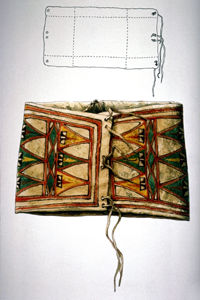Browse "Things"
-
Article
Pan-Indianism
Pan-Indianism is a movement of Aboriginal resistance to domination and assimilation and is characterized primarily by political and religious expression and solidarity. Key historical figures include Pontiac and Handsome Lake.
"https://d2ttikhf7xbzbs.cloudfront.net/media/media/174cee51-4aca-4a67-ac60-f72697d35862.jpg" // resources/views/front/categories/view.blade.php
https://d2ttikhf7xbzbs.cloudfront.net/media/media/174cee51-4aca-4a67-ac60-f72697d35862.jpg
-
Article
Pandemics in Canada
A pandemic is an outbreak of an infectious disease that affects a large proportion of the population in multiple countries or worldwide. Human populations have been affected by pandemics since ancient times. These include widespread outbreaks of plague, cholera, influenza and, more recently, HIV/AIDS and COVID-19. In order to slow or stop the spread of disease, governments implement public health measures that include testing, isolation and quarantine. In Canada, public health agencies at the federal, provincial and municipal levels play an important role in monitoring disease, advising governments and communicating to the public. Click here for definitions of key terms used in this article.
"https://d2ttikhf7xbzbs.cloudfront.net/media/media/933d22b6-a1f6-4f72-9aa4-78cfb4b1a2c8.jpg" // resources/views/front/categories/view.blade.php
https://d2ttikhf7xbzbs.cloudfront.net/media/media/933d22b6-a1f6-4f72-9aa4-78cfb4b1a2c8.jpg
-
"https://development.thecanadianencyclopedia.ca/images/tce_placeholder.jpg?v=e9dca980c9bdb3aa11e832e7ea94f5d9" // resources/views/front/categories/view.blade.php
https://development.thecanadianencyclopedia.ca/images/tce_placeholder.jpg?v=e9dca980c9bdb3aa11e832e7ea94f5d9
-
Article
Canada at the Paralympic Games
The Paralympic Games are an international competition for elite athletes with a disability. The name comes from "para," as in "parallel" or "equal." Like the Olympics, the Paralympic Games take place every two years, alternating between summer and winter sports. The country hosting the Olympic Games also hosts the Paralympics. Canada has participated in the Paralympic Games since 1968.
"https://d2ttikhf7xbzbs.cloudfront.net/media/media/7337b900-7e88-4fbb-9b73-2871d6da290e.jpg" // resources/views/front/categories/view.blade.php
https://d2ttikhf7xbzbs.cloudfront.net/media/media/7337b900-7e88-4fbb-9b73-2871d6da290e.jpg
-
Article
Parapan American Games
The Parapan American Games are a multi-sport event for para-athletes (athletes with disabilities) from 28 countries in the Americas and the Caribbean.
"https://d2ttikhf7xbzbs.cloudfront.net/media/media/a86f7e71-ad7a-4020-a225-cb27746daaa1.jpg" // resources/views/front/categories/view.blade.php
https://d2ttikhf7xbzbs.cloudfront.net/media/media/a86f7e71-ad7a-4020-a225-cb27746daaa1.jpg
-
Article
Parasitology
Parasitology is a branch of biology dealing with organisms (animals or, rarely, plants) which live in or on other species (hosts) from which they derive nourishment.
"https://development.thecanadianencyclopedia.ca/images/tce_placeholder.jpg?v=e9dca980c9bdb3aa11e832e7ea94f5d9" // resources/views/front/categories/view.blade.php
https://development.thecanadianencyclopedia.ca/images/tce_placeholder.jpg?v=e9dca980c9bdb3aa11e832e7ea94f5d9
-
Collection
Parasport
Parasport is sport for athletes with a disability. The name comes from para, as in parallel or equal. Some parasports (such as wheelchair basketball) have been adapted from able-bodied sports, but others (such as goalball) are unique to parasport.
"https://d2ttikhf7xbzbs.cloudfront.net/media/media/085c167d-8730-4b1b-a4e7-803dbb057b46.JPG" // resources/views/front/categories/view.blade.php
https://d2ttikhf7xbzbs.cloudfront.net/media/media/085c167d-8730-4b1b-a4e7-803dbb057b46.JPG -
Macleans
Parents of Victims Speak
This article was originally published in Maclean’s magazine on October 16, 1995. Partner content is not updated.
"https://development.thecanadianencyclopedia.ca/images/tce_placeholder.jpg?v=e9dca980c9bdb3aa11e832e7ea94f5d9" // resources/views/front/categories/view.blade.php
https://development.thecanadianencyclopedia.ca/images/tce_placeholder.jpg?v=e9dca980c9bdb3aa11e832e7ea94f5d9
-
Article
Parfleche
Parfleche (also parflêche) are containers made of rawhide that were used by a variety of Plains Indigenous peoples to carry their personal belongings during hunting trips or while migrating from one location to another. Rawhide was also used to create drumheads, tipi covers, robes, the soles of moccasins and other belongings. Colourful and beautifully decorated, parfleche is considered as much a piece of art as it was a practical tool.
"https://d2ttikhf7xbzbs.cloudfront.net/media/media/7f9f1d10-b91c-42f2-be30-0d650076b5cf.jpg" // resources/views/front/categories/view.blade.php
https://d2ttikhf7xbzbs.cloudfront.net/media/media/7f9f1d10-b91c-42f2-be30-0d650076b5cf.jpg
-
Article
Paris Crew
The Paris Crew was a rowing team from Saint John, New Brunswick, that achieved global acclaim days after Confederation by placing first at the International Regatta during the Paris Exposition of 1867.
"https://d2ttikhf7xbzbs.cloudfront.net/media/media/2d0709de-87e8-4ad5-9abe-3da1d402b285.jpg" // resources/views/front/categories/view.blade.php
https://d2ttikhf7xbzbs.cloudfront.net/media/media/2d0709de-87e8-4ad5-9abe-3da1d402b285.jpg
-
Macleans
Parkinson's Disease a Mystery
A doctor's diagnosis can land like a punch in the solar plexus: you have Parkinson's disease. Chronic, progressive and incurable. In the life-altering reverberations that follow come the questions.This article was originally published in Maclean's Magazine on April 29, 2002
"https://development.thecanadianencyclopedia.ca/images/tce_placeholder.jpg?v=e9dca980c9bdb3aa11e832e7ea94f5d9" // resources/views/front/categories/view.blade.php
https://development.thecanadianencyclopedia.ca/images/tce_placeholder.jpg?v=e9dca980c9bdb3aa11e832e7ea94f5d9
-
Article
Parks Canada
The federal agency now known as Parks Canada was established in 1911 under the name of the Dominion Parks Branch. Charged with administering a small group of parks and reserves, it was the world's first national parks service.
"https://development.thecanadianencyclopedia.ca/images/tce_placeholder.jpg?v=e9dca980c9bdb3aa11e832e7ea94f5d9" // resources/views/front/categories/view.blade.php
https://development.thecanadianencyclopedia.ca/images/tce_placeholder.jpg?v=e9dca980c9bdb3aa11e832e7ea94f5d9
-
Article
Parliament
The term Parliament refers to the Crown, the House of Commons and the Senate. Together, these institutions create Canadian laws. Parliament has two branches: the executive (the Crown, prime minister and cabinet) and the legislative (the House of Commons and the Senate). This system is a blend of parliamentary democracy and constitutional monarchy. It is based on the Westminster tradition in Britain. Each of the Crown, Senate and Commons must agree with (assent to) a law before it is enacted. The government of the day derives its authority from the people who elected it. It is therefore a representative government, even though it acts in the name of the Crown — a largely symbolic institution. In formal terms, Parliament includes all three bodies. But in common usage, the legislative branch is often equated with Parliament.
"https://d2ttikhf7xbzbs.cloudfront.net/media/media/dbd84edd-1c5c-4e10-ba3f-8b0c546b08c7.jpg" // resources/views/front/categories/view.blade.php
https://d2ttikhf7xbzbs.cloudfront.net/media/media/dbd84edd-1c5c-4e10-ba3f-8b0c546b08c7.jpg
-
Article
Parliament Hill Attack
On 22 October 2014, Parliament and the National War Memorial in Ottawa were the targets of an unprecedented attack by a lone gunman. The shooter killed Corporal Nathan Cirillo, a ceremonial guard at the War Memorial, and then charged into Parliament, where he was shot to death inside. The attack raised questions about parliamentary security and sparked a national debate over the nature of terrorism.
"https://d2ttikhf7xbzbs.cloudfront.net/media/media/731e3daa-fce9-4322-8a2a-499deb109b52.jpg" // resources/views/front/categories/view.blade.php
https://d2ttikhf7xbzbs.cloudfront.net/media/media/731e3daa-fce9-4322-8a2a-499deb109b52.jpg
-
Macleans
Parliament Legislates End to Strike
While the two sides in the rail strike remained at loggerheads last week, the government moved quickly to end the dispute.This article was originally published in Maclean's Magazine on April 3, 1995
"https://d2ttikhf7xbzbs.cloudfront.net/media/media/629e4435-3bac-43fb-8d0d-e7676d4693a9.jpg" // resources/views/front/categories/view.blade.php
https://d2ttikhf7xbzbs.cloudfront.net/media/media/629e4435-3bac-43fb-8d0d-e7676d4693a9.jpg

